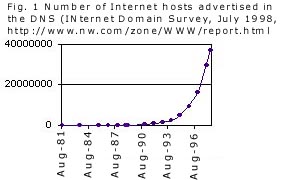
Chemistry International
Vol. 21, No.2, March 1999
1999, Vol. 21
No. 2 (March)
.. News from IUPAC
.. Other Societies
.. Reports from IUPAC
Bodies
.. New Books
..
Reports from Commissions
.. Prizes and Awards
.. Conference Announcements
.. Conferences
CI
Homepage
Chemistry International
Vol. 21, No. 2
March 1999
News from IUPAC
Bioinformatics and the Internet
Dr. Jürgen Pleiss and Professor Rolf D. Schmid, Chairman and Titular Members of the IUPAC Commission on Biotechnology (Institute for Technical Biochemistry, University of Stuttgart, Allmandring 31, D-70569 Stuttgart, Germany; e-mail: [email protected]; [email protected]), contributed the following article on the combination of two new technologies that are having a major impact on the pharmaceutical, agrochemical, and food industries.
Introduction
Explosive Growth of the World Wide Web
Life Sciences and the World Wide Web
Protein Sequencing Databanks
Bioinformatics Databanks and Web Sites
Challenges to Bioinformatics
Future of Bioinformatics
ReferencesIntroduction
At the turn of the millennium, two young technologies can be singled out which have a major impact on science, industry, and society: recombinant DNA and information technology. As they combine in the field of bioinformatics, they are transforming the pharmaceutical, agrochemical, and food industries and, as a consequence, university education. Much of today's information in the life sciences is generated by collaborative efforts at different locations worldwide, and effective communication is essential for success. Thus, the huge amount of data generated by large-scale genome sequencing activities, e.g., the human genome project, depends heavily on computing and telecommunications and stimulates further efforts in this area.Explosive Growth of the World Wide Web
In information technology, the World Wide Web (WWW) has become the dominant global communication network. It is based on the Internet, which has served already for more than 20 years as a communication resource among scientists. But only when the hypertext transfer protocol (HTTP) was introduced in 1990 did communication via the Internet became sufficiently easy and inexpensive to allow its general use. Moreover, HTTP is hardware-independent and thus accessible even through inexpensive personal computers which are connected directly to the Internet or via a modem to an Internet provider.
This development has stimulated all kinds of commercial activities, and the number of Internet hosts and Internet web sites has reached nearly 40 and 4 million (Fig. 1: Number of Internet hosts advertised in the DNS - Internet Domain Survey, July 1998, http://www.nw.com/zone/WWW/report.html), respectively1. At present, the number of web sites doubles every year, 100 million people worldwide are estimated to be active Internet users, and business on the order of USD 8 billion is done via the Internet. It is expected that within two more years the number of active users might increase tenfold to reach 1 billion, a dramatic increase driven mainly by the populous Asian nations, and that Internet-based sales will account for USD 300 billion or 1% of all global sales within only four years.
Life Sciences and the World Wide Web
Though by now a majority of the 4 million web sites have a commercial background, the scientific use of the WWW will increase as well. Among the initiatives to enhance its quality and speed up transfer of large volumes of data, the Internet2 project is the most ambitious. It will start by mid-1999 with 141 participating universities and 14 companies across the United States. The Internet2 will serve exclusively scientific purposes and "facilitate and coordinate the development, deployment, operation, and technology transfer of advanced, network-based applications and network services to further U.S. leadership in research and higher education and accelerate the availability of new services and applications on the Internet"2.Even now in the era of Internet commerce, many thousands of WWW sites are devoted to the global science network. In fact, many recent discoveries and developments, particularly in the life sciences, would be unthinkable without the Internet. The modern era of life sciences started in the 1950s and accelerated in the early 1970s, when the modern tools of genetic engineering were developed, i.e., how to isolate, sequence, and clone DNA and express it in a host organism of one's choice. In those early days, DNA sequencing was cumbersome and restricted to single genes, minor gene clusters, or small virus genomes. In order to store the resulting DNA sequences, the National Biomedical Research Foundation, Washington, DC, USA, created the first sequence databank in 1965.
News and Notices - Organizations and People - Standing Committees
Divisions - Projects - Reports - Publications - Symposia - AMP - Links
Page last modified 11 June, 1999.
Copyright © 1997, 98, 99 International Union of Pure and Applied Chemistry.Questions or comments about IUPAC, please contact the Secretariat.
Questions regarding the website, please contact [email protected]
